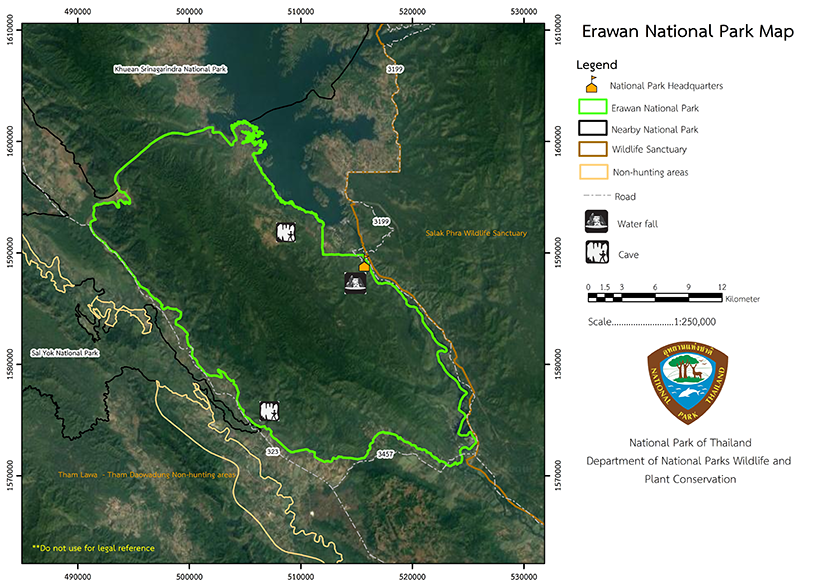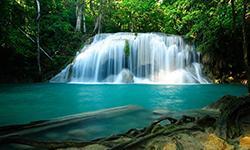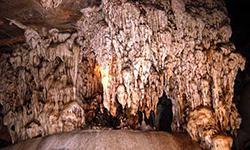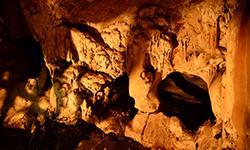Erawan National Park
Contact Location : Erawan National Park, Moo 4, Tha Kradan Sub-district, Si Sawat District, Kanchanaburi Province 71250
Telephone Number : (+66)3 457 4222, (+66) 3 457 4234
Email : erawan2518.np@gmail.com
Facebook : Erawan National Park
Background
When the Field Marshal Sarit Thanarat was Prime Minister, on October 7th, 1959, the Cabinet passed a resolution assigning Ministry of Agriculture (Currently called the Ministry of Agriculture and Cooperatives) to establish a forest in Salop Mountain range , Kanchanaburi Province, and other forest in various provinces, totaling 14 forests as National Parks. Between 1961 and 1972, Royal Forest Department dispatched personnel to conduct preliminary investigations centered around Erawan Waterfall. It was discovered that Khao Salob forest area in Kanchanaburi Province was surrounded by breathtaking scenery and abundant natural resources.
However, the aforementioned area is included in the restricted land by the Royal Decree including the areas in Mueang District, Wang Khanai District, Ban Thuan District, and Wang Ka District in Kanchanaburi Province, where the Minister of Defense and the Ministry of the Interior were responsible for enforcing the said Royal Decree. The Royal Forest Department therefore informed the Ministry of Agriculture and Cooperatives to inform the Ministries of Defense and Interior to revoke some of the restricted land areas in Salob area that are forested as national park areas. The National Park Board has approved the establishment of the national parks. A Royal Decree revoking the restrictions was published in the Government Gazette on June 19, 1975, and another Royal Decree established the area of Khao Salop forest land, including Sai Yok, Tha Sao and Lum Sum, Nong Pet and Tha Kradan, Chong Sadao Sub-district in Sai Yok, Si Sawat and Mueang Distric in Kanchanaburi Province to be designated as national parks in 1975 and named "Erawan National Park" due to the popularity and familiarity of the Erawan Waterfall among the locals. This national park, with an area of approximately 550 square kilometers or 343,750 rai, was the country's 12th national park.
Following that, in 1995, a Royal Decree revoked portions of Erawan National Park in Tha Kradan Sub-district, Si Sawat District area, which covered an area of 15 rai (0.024 square kilometers). The total area then is 550 square kilometers or 343,735 rai.
Note : After paying the entrance fee to the National Park, please carry the receipt for inspection.

343,735 rai (550 square kilometers)
|
|
|
||
|
|
|||
Nature trails ⇔ Visit Waterfall ⇔ Cave exploration/Geological condition ⇔ Observe flowers/plants ⇔ Bird/Butterfly ⇔ Camping
Welfare shop : open daily from 8:00 to 16:30 hrs.
Mobile phone signal :
- National Park Headquarters: AIS, TRUE, DTAC
- Erawan Waterfall, 1st-tier: AIS, TRUE, DTAC
- Erawan Waterfall, 2nd-tier: AIS, TRUE, DTAC
- Erawan Falls, 3rd-tier: AIS, TRUE
- Erawan Falls, 4th-tier: AIS, TRUE
- Erawan Falls, 7th-tier: AIS, TRUE
- Erawan National Park Ranger Station O Wo No. 1 (Phra That Cave): AIS *The signal is unstable, but the best is at the National Park Headquarters.
|
|
Erawan National Park is defined by tower karst and mountainous areas ranging in elevation from 165 to nearly 1,000 meters. The area is mostly karst topography, which rise vertically in the east and the west of the area, especially near Erawan Waterfall. There are also plains in the central region, which has a long mountain range. The mountain range runs from the northwest to the southeast and is composed of essential mountains, including Khao Nong Phuk, Khao Plai Dinsor, Khao Mo Thao, Khao Chong Pun, Khao Phurang Rin, and Khao Kro Krae.
|
|
The Erawan National Park's climate is classified into three seasons: The southwest and northeast monsoons influence the Erawan National Park, bringing rain. However, the area's location is in a rain shadow, thus expecting less rainfall, and the weather is hotter than equivalent areas. As a result, traveling is not affected by rain and it possible to travel throughout the year.
|
|
|
|
|
Forest Features in Erawan National Park Deciduous diptarocarp forests have a under 2 percent of the area and are scattered between elevations of 100 to 800 around the National Park Ranger Stations O Wo No. 8 (Lam Ton) and near Thung Na Dam. Plants include Damnoted Burma Sal, Burmese Sal, Jamba, Quercus kerrii Craib, Malacea Tree, Wodier Tree, Morinda coreia Buch.-Ham, Casearia grewiifolia Vent. var. grewiifolia, Holarrhena pubescens Wall. ex G. Don, Dalbergia lanceolaria L.f. var. lakhonensis (Gagnep.) Niyomtham, Great Elephant Apple, and Heliciopsis terminalis Sleum,. The survery showed that mammals, reptiles, amphibians, birds, and other aquatic animals, including a diverse array of fish were included in the National Park. The most important and common wildlife are Asian Elephant, Asiatic Black Bear, Serow, Barking Deer, Sambar Deer, Wild Boars, Common Gibbon, Phayre's Leaf-Monkey, Pig-Tailed Macaque, Bengal Slow Loris, Leopard Cat, Common Palm Civet, Chipmunk, and Black Baza. There are also many birds such as Gray-Backed Pheasant, Kalij Pheasant, White-Breasted Waterhen, Common Sandpiper, Eastern Spotted Dove, Greater Coucal, Indian Roller, Grey-Capped Pygmy Woodpecker, Streak-Eared Bulbul, Pellorneum ruficeps, as well as reptiles and amphibians, such as King Cobra, Banded Krait, Burmese Python, Indo-Chinese Rat Snake, Blue Crested Lizard, Many-Lined Sun Skink, Southeast Asian Softshell Turtle, Asian Common Toad, Puddle Frog, Hill Forest Frog, Tree Frog, Phlogacanthus pulcherrimus T.Anderson, Greater Brook Carp, Striped Tiger Nandid, Java Barb, Eye-Spot Barb, Waterfall Crabs, Crabs of Tenasserim, and Kanchanaburi Crabs. |
How to get there by car :
From Bangkok, drive towards Kanchanaburi, with the entire journey being 129 kilometers taking about 1.30 hours.
From Kanchanaburi city to Erawan National Park, visitors can use two routes:
Route 1: They depart from Kanchanaburi Province and travel along Provincial Highway No. 3199 to Electricity Generating Authority of Thailand at Sinakharin Dam, where a bridge crosses the Sinakharin Dam at the market. From there you can reach Erawan National Park Headquarters, which is a total distance of about 70 kilometers.
Route 2: From Sai Yok National Park, there is a road near Ban Wang Yai, which is about 6 kilometers from Sai Yok Noi Waterfall. Take a shortcut to Ban Pong Pat, near Tha Thung Na Dam, for about 15 kilometers, and turn left onto Highway No.3199 for about 25 kilometers to Erawan National Park Headquarters.
How to get there by Train
The train departs Bangkok Noi Railway Station twice daily and makes stops at Kanchanaburi station River Khwae Bridge Station, Tha Kilen Station, and Nam Tok Station. On Saturdays, Sundays, and national holidays, a special travel train operates a one-day round trip. For more information, contact Kanchanaburi Railway Station at 0 – 3451-1285.
How to get there by Bus
Regular buses and air-conditioned buses depart from Southern Bus Terminal every 15 minutes between 4:00 and 20:30 hrs. for Kanchanaburi. It is approximately a 2.30 hours journey. Following that, take Kanchanaburi Bus No. 8170 from Kanchanaburi which depart every hour between 8:00 and 17:20 hrs. There is also a bus from Bangkok to Erawan which departs from Mo Chit Bus Terminal 2, Floor 1, Platform 21, Bangkok - Dan Chedi Sam Ong , between 5:00 and 19:00 hrs., with a stop at Kanchanaburi Bus Terminal. It takes approximately two hours and thirty minutes. Following that, take Kanchanaburi - Erawan bus to Erawan National Park.
- National Park Ranger Station O Wo No. 1 (Phra That Cave)
- National Park Ranger Station O Wo No. 2 (Plai Dinsor)
- National Park Ranger Station O Wo No. 3 (Wang Badan)
- National Park Ranger Station O Wo No. 4 (Thap Sila)
- National Park Ranger Station O Wo No. 5 (Pha Lan)
- National Park Ranger Station O Wo No. 6 (Matum)
- National Park Ranger Station O Wo No. 7 (Nong Bon)
- National Park Ranger Station O Wo No. 8 (Lam Ton)
- Restaurant-Restaurant
Accommodation - Campground
- Erawan 932 (Boys Youth Camp)
- Erawan 931 (Girls Youth Camp)
- Erawan 202/4 (Rim Than)
- Erawan 202/3 (Rim Than)
- Erawan 202/2 (Rim Than)
- Erawan 202/1 (Rim Than)
- Erawan 201/4 (Rim Phrai)
- Erawan 201/3 (Rim Phrai)
- Erawan 102 (Twin Room)
- Erawan 103 (Erawan)
- Erawan 105 (Rim Khwae)
- Erawan 106 (Sakae Daeng)



